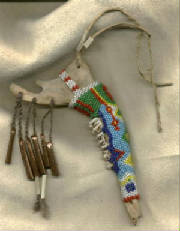|

This is a small jawbone from a white tail deer. It is covered on both sides with little seed beads employing a loose variation
of the Gourd Stitch. This beading technique is described very well in the Whispering Winds Crafts Annual #3, 1990. Check www.whisperingwind.com
or www.writtenherritage.com for more information on this informative publication.
I started on the front end of the jaw where the teeth used to be and worked my way back behind the molars. The best way
to go about this it to just do it and eyeball it along the way because every jawbone is different and every bead is a slightly
different size. Pass the thread between each tooth to anchor your work.
I originally had a plume of horsehair tied to the end where the front teeth had been and there used to be pheasant feathers
tucked up in the two pieces of squirrel bone in the jingle cones. These fell off over the course of years and I just have
not replaced them yet. Two more segments of squirrel bone are on the hanging cords. The copper jingle cones are hand made.
They hang from hand spun bear wool.
|
 |
|
|
|
 |
|
A Note on Bead Work:
Beads were introduced by the Europeans as trade goods. They replaced porcupine quillwork as a favorite form of decoration.
The beads offered a wider range of colors, were easier to work with and could be sewn without any preparation, unlike quills
which had to be gathered, sorted, cleaned, dyed with vegetable colors and then softened to make them pliable before they could
be stitched. The only advantage quills had over beads was they weigh much less. An article covered in glass trade beads was
much heavier than one of porcupine quill embroidery.
|
 |
|
|
|

